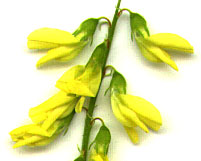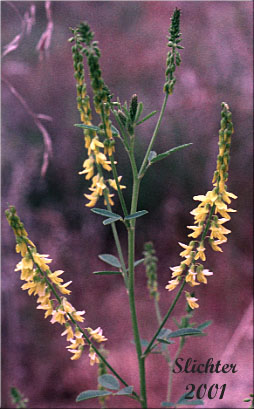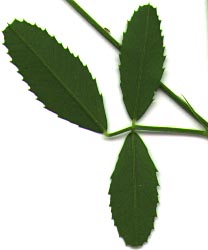

 The
photo at right depicts yellow sweet-clover from the Painted Hills Unit, John
Day Fossil Beds N.M.......May 24, 1998.
The
photo at right depicts yellow sweet-clover from the Painted Hills Unit, John
Day Fossil Beds N.M.......May 24, 1998.Yellow sweet-clover is a winter annual or biennial with several stems ascending from 50-300 cm high. The compound-ternate leaves (3 leaflets) are found on the stems and they resemble those of alfalfa, except the latter are toothed only on the distal portion of the leaflet while those of the former are toothed along most of the leaflet margin. Individual leaflets are linear to elliptic, oblanceolate, or obovate in shape.
The inflorescence is a raceme from 3-10 cm long. The racemes are terminal as well as axillary. The flowers are yellow (fading to cream) and 4-6 mm long. The teeth of the calyx are narrowly lanceolate in shape. The wrinkled pods are about 3 mm long and contain 1 or 2 seeds. A single plant may produce over 100,000 seeds.
Although considered a weedy plant, some advocate its use as stabilizing plant on disturbed soils, as it is one of the first to live in disturbed places. It is also favored by some honey producers. Consumption by cattle may cause bloat, and "wild" plants contain coumarin which causes anticoagulation of the blood.
Other common names for yellow sweet-clover include king's crown, plaster clover, Hart's clover, king's clover, and yellow millet.
Yellow sweet-clover is a weedy species of disturbed places such as roadsides and waste areas.
Introduced from the Mediterranean region of Europe, yellow sweet-clover is a weedy species which may be found throughout the Rocky Mt region extending west towards the Cascade Mts. It is not as common west of the Cascades.
